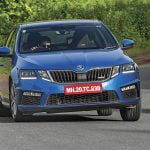
A Honda Urban EV concept car is presented at the Frankfurt Auto Show (Photo credit TOBIAS SCHWARZ/AFP/Getty Images)
The Frankfurt Auto Show is over for another two years, and by the time the next one comes around, the electric revolution should be in full swing.
The strange thing is that visitors to the show might have been forgiven for thinking that the revolution had already started. All the big auto manufacturers were touting their electric credentials, but it was more like a speakeasy joint in the days of prohibition. All the healthy fruit juices and sparkling water on show at the front were just for show. The real stuff, what the punters really wanted, the diesels and gasoline-powered machines, were at the back of the place.
By the fall of 2019, things will probably look a lot different. Or will they?
Governments, and big manufacturers anxious to please them, huff and puff about how, by 2025, perhaps 25% of all new cars sold will be electric only.
But talk to the practical, supplier side of the industry, preparing for the future based on concrete orders and reality, and you get a different story. Big global suppliers paint a radically different picture, calculating only 2% to 6% will be electric-only between 2023 and 2025.

Harald Krueger, CEO of German carmaker BMW and the German Chancellor Angela Merkel pictured at the presentation with electric cars at the 2017 Frankfurt Auto Show (Photo by Thomas Lohnes/Getty Images)
Frederic Lissalde, vice president of BorgWarner, agrees that the shift away from ICE (internal combustion engine) to hybrids and battery power is inevitable, but his idea of the pace of change shows this will be gradual, and not an overnight, revolution.
“By 2023, the global market share of electric vehicles will be a bit more than 2%, up from 0.6% in 2016. ICE power will still be huge – 80% in 2023 compared with 96% now — while hybrids will accelerate ahead to 17%, compared to 3.3% in 2016,” Lissalde said.
Magna International said in August that it sees a global EV share of between 3% and 6% by 2025. At the same time, Delphi Automotive went for 5%.
According to investment researcher Jefferies, there was an air of unreality in Frankfurt.
“Frankfurt’s IAA 2017 wasn’t just about cars but felt like a ‘political’ show, with [manufacturers] keen to burnish emission credentials through electrification ,” Jefferies analyst Philippe Houchois said.
Houchois said: “Auto shows have been hijacked by the theme of EVs for some time, but diesel issues have clearly added a sense of urgency in Europe. European roll-out of EVs remains slow, but Europe-based (manufacturers) are clearly embracing BEVs and implicitly agreeing that PHEVs (plug-in hybrid) will remain a niche or transition technology.”
Citi Research analyst Michael Tyndall said the industry is in the midst of transition.
“We suspect the carmaker that proves it has a viable – read profitable – EV business model will be handsomely rewarded. We would argue Renault has an early lead, at least on volumes, but if the higher costs associated with EVs require higher pricing, it might be Daimler and/or VW that steal a march on the rest of the group,” Tyndall said.
Tyndall pointed to Chinese manufacturers like Borgward, Chery and Wey, which are hidden in an obscure corner of the show but seemed to be competitive in terms of materials and quality.
Bernstein Research analyst Max Warburton agreed about the propaganda nature of the show.
“All the diesel models were hurriedly pushed to the back of the show stands, with pure EVs, plug-in hybrids and new concepts front and centre. A lot of these concepts are ‘vaporware’ and will never be built. But the intent is greater than before, and some will come to market,” Warburton said.
Warburton believed the diesel issue is manageable, for now. He came away from the show with five main conclusions:
- Traditional industry is fighting back. In among the vaporware and promises of 20, 50, 100 EVs by 2025, there were plenty of promising vehicles that will soon be on the market.
- Daimler is most serious about EVs. The whole company appears on the front EV foot. The EQ GLC arrives in 2019, followed by electric models in all segments, including a Tesla Model 3 rival. BMW seems half-hearted despite the i Vision Concept, likely to be the i5, after losing big money with the i3. VW is in the middle, pressured by Dieselgate ignominy to appear as green as possible.
- Many cynical, concerned executives, unconvinced the public is ready to go for electric cars. Warburton found top execs sounding convinced about an electric future while the infantry can’t see it.
- Capital spending is up, but not by that much.
- Near-term trading looks strong. Earnings claims were confidently positive despite slowing sales growth. Diesel remains manageable, for now.
Ian Fletcher, IHS Markit analyst, said electrification will come at a huge cost, even for the most financially strong companies. He pointed out, though, that BMW and Daimler have stated diesel will remain an important part of the engine mix for years to come while VW ICE power will provide a bridgehead to new technologies.
Perhaps the demise of conventional engines has a ways to go yet.
[“Source-forbes”]





